
Annibale Carracci was an Italian painter and instructor, active in Bologna and later in Rome. Along with his brother and cousin, Annibale was one of the progenitors, if not founders of a leading strand of the Baroque style, borrowing from styles from both north and south of their native city, and aspiring for a return to classical monumentality, but adding a more vital dynamism. Painters working under Annibale at the gallery of the Palazzo Farnese would be highly influential in Roman painting for decades.

Giovanni Lanfranco was an Italian painter of the Baroque period.
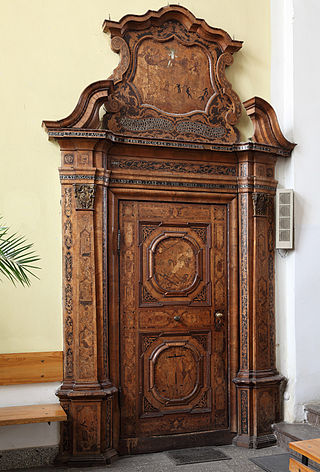
An "overdoor" is a painting, bas-relief or decorative panel, generally in a horizontal format, that is set, typically within ornamental mouldings, over a door, or was originally intended for this purpose.

Giovanni Battista Caracciolo (1578–1635) was an Italian artist and important Neapolitan follower of Caravaggio. He was a member of the murderous Cabal of Naples, with Belisario Corenzio and Giambattista Caracciolo, who were rumoured to have poisoned and disappeared their competition for painting contracts.

The Pinacoteca di Brera is the main public gallery for paintings in Milan, Italy. It contains one of the foremost collections of Italian paintings from the 13th to the 20th century, an outgrowth of the cultural program of the Brera Academy, which shares the site in the Palazzo Brera.
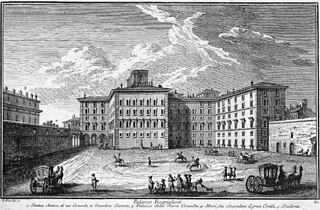
The Palazzo Pallavicini-Rospigliosi is a palace in Rome, Italy. It was built by the Borghese family on the Quirinal Hill; its footprint occupies the site where the ruins of the baths of Constantine stood, whose remains still are part of the basement of the main building, the Casino dell'Aurora. Its first inhabitant was the famed art collector Cardinal Scipione Borghese, the nephew of Pope Paul V, who wanted to be housed near the large papal Palazzo Quirinale. The palace and garden of the Pallavicini-Rospigliosi were the product of the accumulated sites and were designed by Giovanni Vasanzio and Carlo Maderno in 1611–16. Scipione owned this site for less than a decade, 1610–16, and commissioned the construction and decoration of the casino and pergolata, facing the garden of Montecavallo. The Roman palace of this name should not be mistaken for the panoramic Villa Pallavicino on the shores of Lake Como in Lombardy.

Mattia Preti was an Italian Baroque artist who worked in Italy and Malta. He was appointed a Member of the Order of Saint John.

Francesco Cozza was an Italian painter of the Baroque period.

Butcher's Shop is the title of two paintings by the Italian Baroque painter Annibale Carracci, both dating from the early 1580s. They are now in the collections of Christ Church Picture Gallery, Oxford, and the Kimbell Art Museum in Fort Worth, Texas.
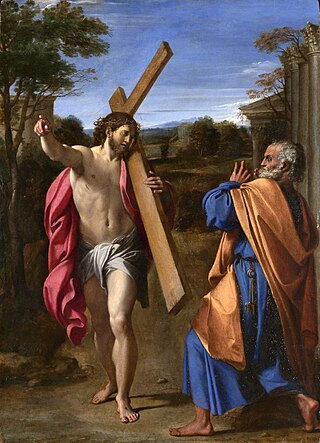
Domine, quo vadis? is a 1602 painting by the Italian Baroque painter Annibale Carracci (1560–1609), depicting a scene from the apocrypha Acts of Peter. It is housed in the National Gallery, where it is given the title Christ appearing to Saint Peter on the Appian Way. The subject is a rare representation in art of the theme Quo vadis. Annibale Carracci was the founder of the Italian Baroque painting school, called Bolognese School. This painting is one of his best known works. Peter is depicted fleeing Rome to avoid crucifixion and has a vision of meeting Christ bearing his Cross. Peter asks Jesus "Quo vadis?" to which he replies, "Romam vado iterum crucifigi". Peter returns to Rome after this vision.
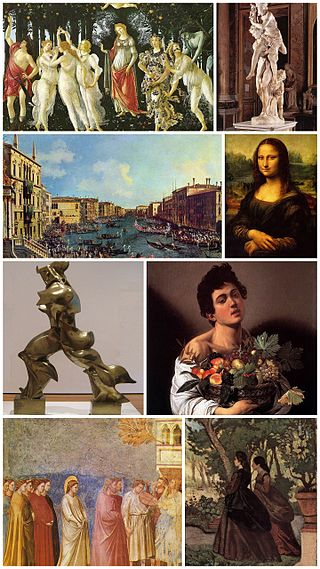
Italian Baroque art is a term that is used here to refer to Italian painting and sculpture in the Baroque manner executed over a period that extended from the late sixteenth to the mid eighteenth centuries.

Pietà is a c. 1600 oil on canvas painting by Annibale Carracci, the earliest surviving work by him on the subject, which was commissioned by Odoardo Farnese. It moved from Rome to Parma to Naples as part of the Farnese collection and is now in the National Museum of Capodimonte in Naples. It is one of many 16th century Bolognese paintings dedicated to the theme of the Pietà, and it is counted among Carracci's masterpieces.
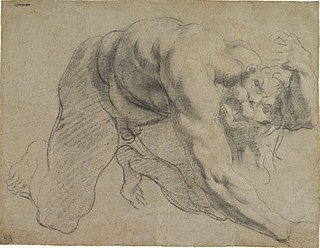
The Palazzo Sampieri frescoes are a set of paintings by Annibale, Agostino and Ludovico Carracci in the Palazzo Sampieri in Bologna. They form the last surviving collection of works by the three artists.
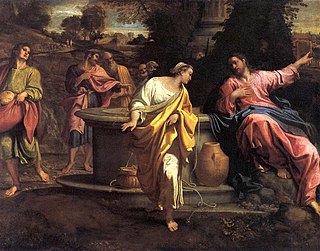
Christ and the Samaritan Woman or The Woman at the Well is a 1593-1594 oil on canvas painting by Annibale Carracci, painted as part of the same scheme as the Palazzo Sampieri frescoes. Several years later he also produced a much smaller autograph copy with variations, now in the Museum of Fine Arts, Budapest.

Christ and the Canaanite Woman is a 1594-1595 oil on canvas painting by Annibale Carracci, now in the Pinacoteca Stuard in Parma.
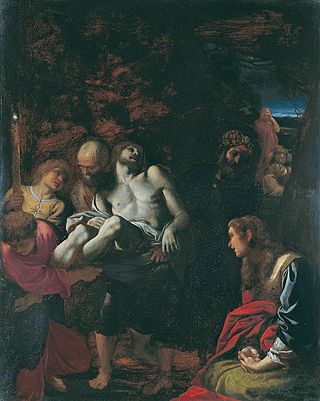
Entombment of Christ is a c.1595 oil on copper painting by Annibale Carracci, now in the Metropolitan Museum of Art

The Dead Christ Mourned is an oil painting on canvas of c. 1604 by Annibale Carracci. It was in the Orleans Collection before arriving in Great Britain in 1798. In 1913 it was donated to the National Gallery, London, which describes it as "perhaps the most poignant image in [its] collection of the pietà – the lamentation over the dead Christ following his crucifixion – and one of the greatest expressions of grief in Baroque art".

Christ and the Woman Taken in Adultery is a c. 1650 oil on canvas painting by Mattia Preti.
Christ and the Canaanite Woman is a c. 1650 oil on canvas painting by Mattia Preti. It and another work by Preti showing Christ with a single woman were both recorded as being in the Certosa di San Martino in Naples in 1806, but were split up the following year when Adultery was acquired by the Real Museo Borbonico and Canaanite passed to the church of Sant'Efremo Nuovo. In 1828 the two works and 38 others were given to the Museo della Regia Università degli Studi in Palermo, Sicily by Francis I of the Two Sicilies and they both now hang in the Palazzo Abatellis in the same city.

The Return of the Prodigal Son is a 1656 oil on canvas painting by Mattia Preti, now in the Museo nazionale di Capodimonte in Naples.


















